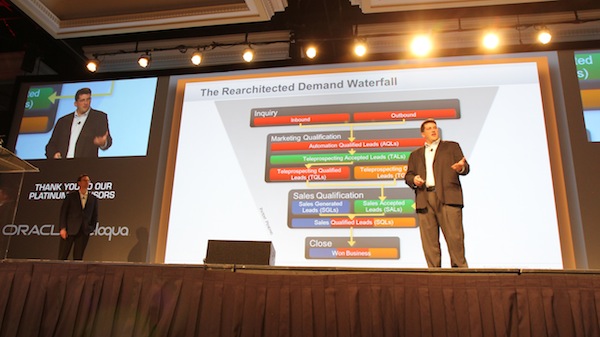Summit 2013 Highlights: Has Your Demand Waterfall Evolved?
As B2B sales and marketing professionals know, the demand creation process has changed significantly over recent years. SiriusDecisions’ rearchitected Demand Waterfall, unveiled one year ago, reflects the new reality with a more complete view of the journey that demand takes from cold to close, as well as the different points at which it originates.
But are organizations taking full advantage of the new phases and stages offered by the revised Demand Waterfall?
Instant poll results at Summit 2013, which is currently underway at the Manchester Grand Hyatt in San Diego, revealed that 43 percent of respondents have implemented or are in the process of implementing the rearchitected version of the Demand Waterfall, while another 31 percent are planning to make the switch in the future.
Teleprospecting’s growing role in lead creation figures prominently in the rearchitected waterfall. Teleprospecting generated leads are tracked from the marketing qualification stage through to the closed-business stage, alongside leads originated from marketing and sales.
“What we’re looking at in the rearchitected waterfall is the relative percentage of demand that originates from these three functions in the pipeline,” explained Jason Hekl, service director of the Demand Creation Strategies service at SiriusDecisions.
The conversion rates and other statistics for companies using the rearchitected demand waterfall during the past year revealed several new trends – and potential process pitfalls.
For example, while companies reported that 33 percent of inquiries were generated by outbound tactics and 30 percent were inbound inquiries – a proportion that SiriusDecisions expects to continue shifting in favor of inbound – 37 percent of inquiries were blended between inbound and outbound sources, reflecting the increasingly complex multi-touch sales environment.
SiriusDecisions’ research also revealed an alarming rise in route-arounds at some companies – leads that are sent directly from marketing to sales, bypassing qualification by the teleprospecting function. When too many leads for complex deals start getting routed directly to sales without going through the agreed-upon qualification process, said Tony Jaros, senior vice president of research at SiriusDecisions, this is often an indicator of trouble aligning the sales, marketing and teleprospecting functions.
Other companies may simply send too many leads to sales, failing to use proper lead scoring methods. Valuing quantity over quality almost always leads to severe lead waste in the waterfall, Jaros said.
Overall, Jaros and Hekl explained, using the rearchitected waterfall requires careful examination of the processes performed by sales, marketing and teleprospecting. Technology platforms and data coding must be optimized to support the waterfall’s execution and measurement, and service-level agreements between marketing, teleprospecting must be consistently executed. While conversion rates are important, performance measurement must not over-emphasize them.
“The problem with conversion rates is that they don’t tell you what you did from a demand standpoint, cost standpoint or scalability standpoint,” Jaros noted.
Maintaining an optimal balance between different sources of leads is critical to a well-functioning demand engine. The SiriusDecisions Demand Balance Index, which is calculated by dividing the yield of the highest-performing lead source by the yield of the lowest-performing source, can reveal future sources of trouble and potential avenues for improvement, Hekl explained.
“Great demand is about more than conversion,” Jaros reminded the audience. “It’s about balance.”
